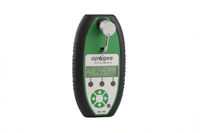FOR SCIENTISTS AND SERIOUS GROWERS - The patented Apogee chlorophyll concentration meter is the premium tool of choice among leading scientists and serious growers for accurately measuring and displaying chlorophyll concentration from intact leaf samples without damaging the plant material. It is calibrated to measure chlorophyll concentration in leaves with units of µmol of chlorophyll per m2. This eliminates problems with relative indices of chlorophyll concentration. For reference and comparison purposes, the meter also outputs relative units (CCI or SPAD).
NON-DESTRUCTIVE MEASUREMENTS - The meter measures the ratio of radiation transmittance from two wavelengths: red, which is strongly absorbed by chlorophyll, and near infrared, which is not absorbed by chlorophyll. Since the meter gauges the wavelengths, and does not rely on entering the leaf, users are able to make measurements non-destructively and nearly instantaneously (measurement time is less than 3 seconds). This facilitates rapid measurement of multiple leaves and the monitoring of the same leaves over time.
VARIABLE SAMPLING AREA - The meter measures the relative chlorophyll concentration over an area of approximately 64 mm2 (circle with 9 mm diameter). A field of view reducer is included to reduce the sampling area to approximately 20 mm2 (circle with 5 mm diameter) for leaves narrower than 9 mm.
TYPICAL APPLICATIONS - The MC-100 is used for chlorophyll concentration determination in leaves for assessment of nutrient status, fertilizer requirements, evaluation of stress, and optimization of harvest. The meter also has specific crop species programmed for easier growing.
PLANT SPECIES - Specific crop species settings in the meter include edible species such as rice, wheat, soybean, barley, pepper, tomato, pea, kohlrabi, Waldmann's green lettuce, buttercrunch lettuce, corn, sorghum, coffee, spinach, grapevine, strawberry, cherry, blackberry, arugula, collard greens, kale, romaine lettuce, and swiss chard. The meter also includes plant species such as quaking aspen, European birch, paper birch, crimson king maple, Norway maple, Japanese maple, boxelder, crab apple, purple leaf sand cherry, lilac, forsythia, cannabis, and hops, as well as a general setting used for all other species.
STORAGE CAPACITY AND INTERNAL GPS - Memory is allocated to data storage, which allows for 160,000 logged measurements. A mini USB port also enables direct connection to a computer to download your data. Chlorophyll meters come with a complimentary standard mini USB to USB cable adaptor for data downloading. New internal GPS inside the meter allows field data to be geo-referenced and stored, with a storage capacity of 94,000 measurements.
FOR MORE PRODUCT INFORMATION, CHECK OUT THESE LINKS
MORE INFORMATION ON CHLOROPHYLL CONCENTRATION METERS >> Click Here








